Abstract
Dynorphin A (Dyn A) and related opioid peptides derived from prodynorphin possess a high affinity for kappa opioid receptors, but they also bind to other opioid receptors (mu and delta) as well as to some non-opioid receptor sites. Although the physiological role of these peptides is not well established, recent experimental data pinpoint their particular involvement in physiological and pathophysiological conditions that relate to algesia, spinal cord injury and epilepsy. In this paper, we review data which support the concept that the non-opioid behavioral effects of Dyn A and related endogenous peptides which are observed under these conditions are physiologically and pathophysiologically relevant.
Full text
PDF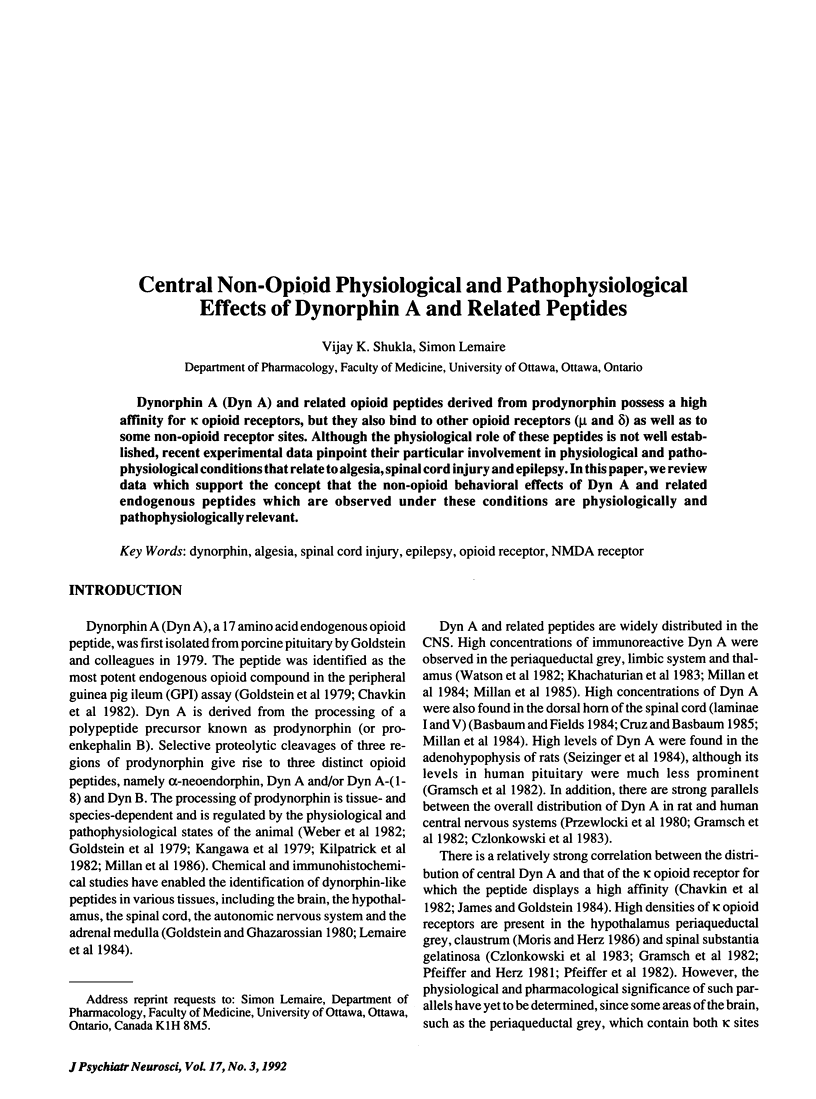
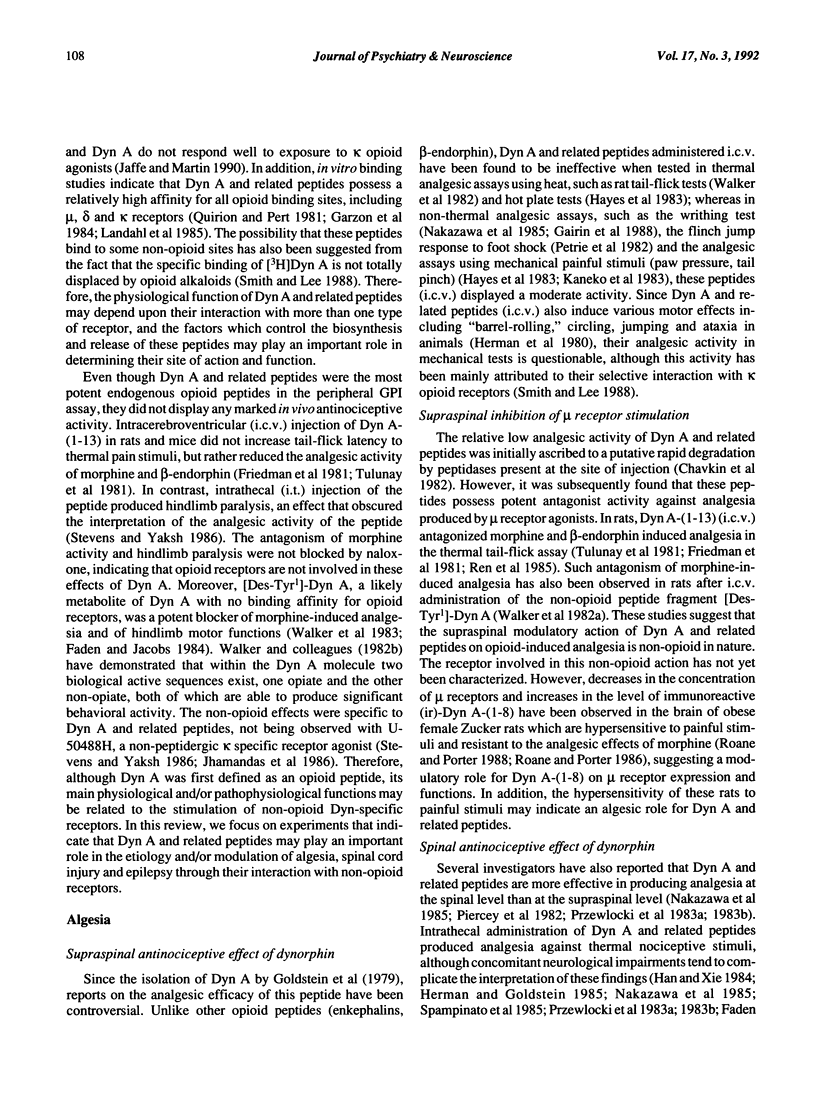
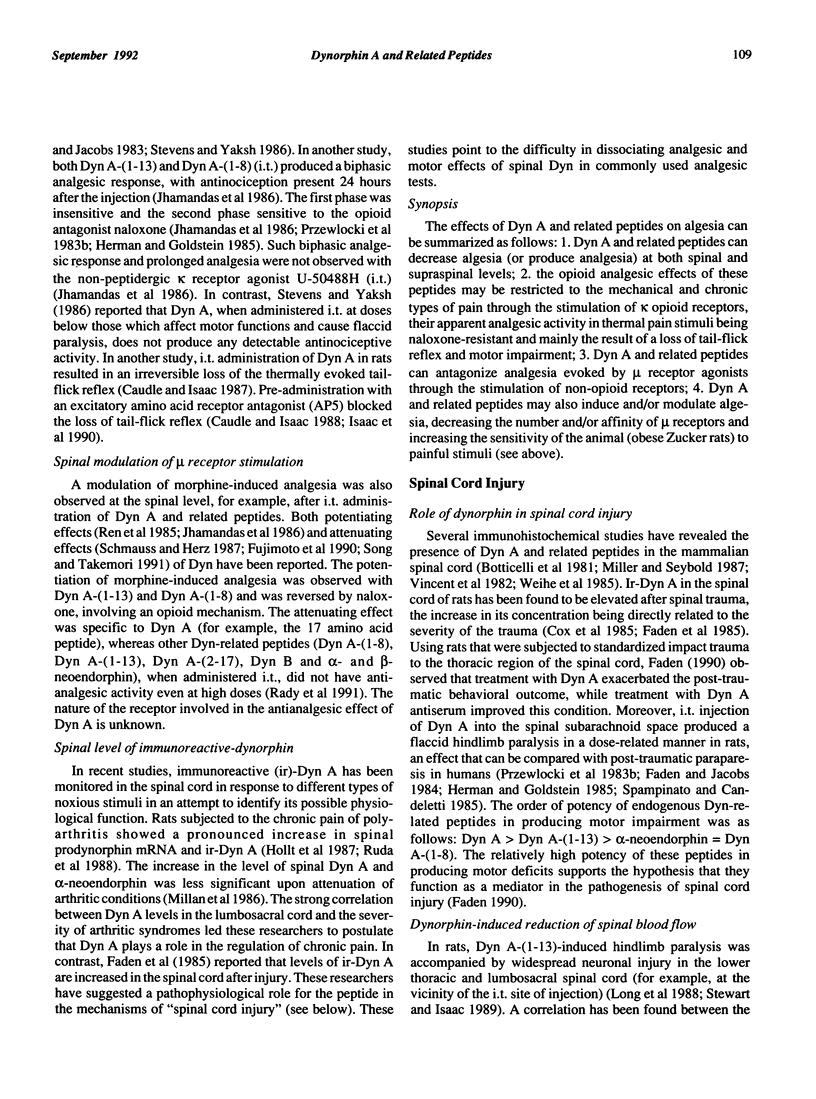



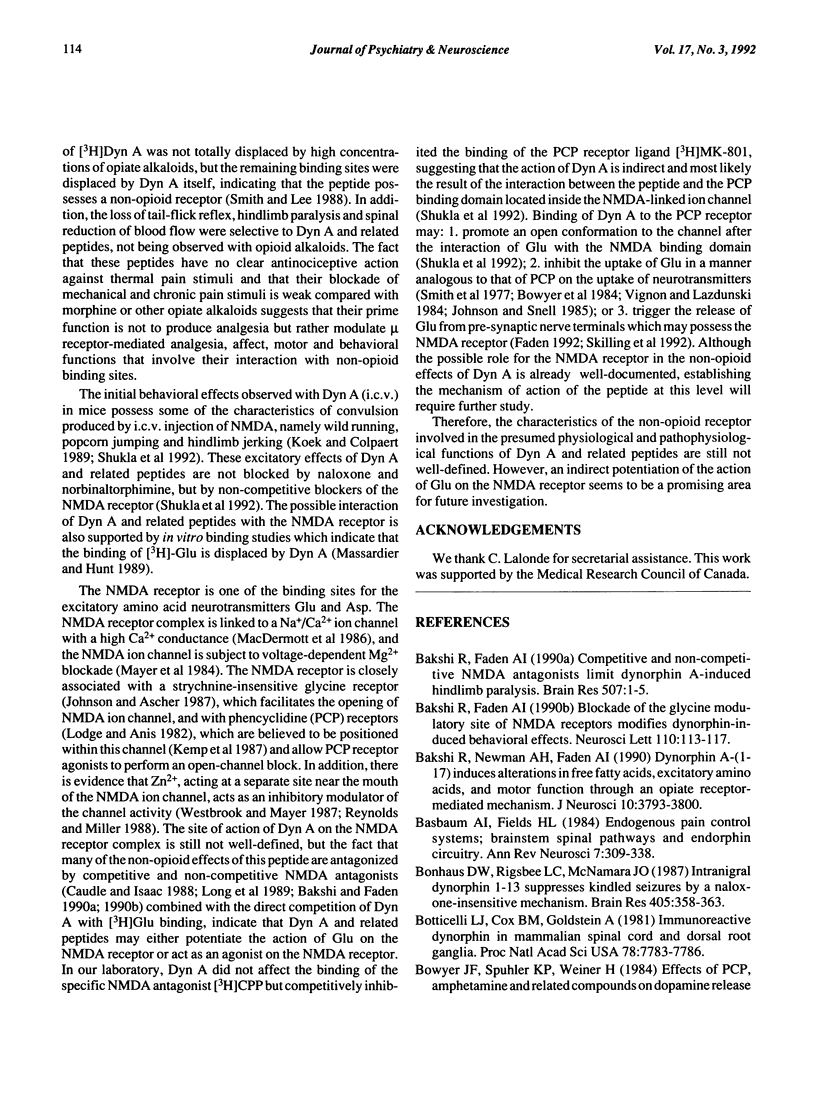
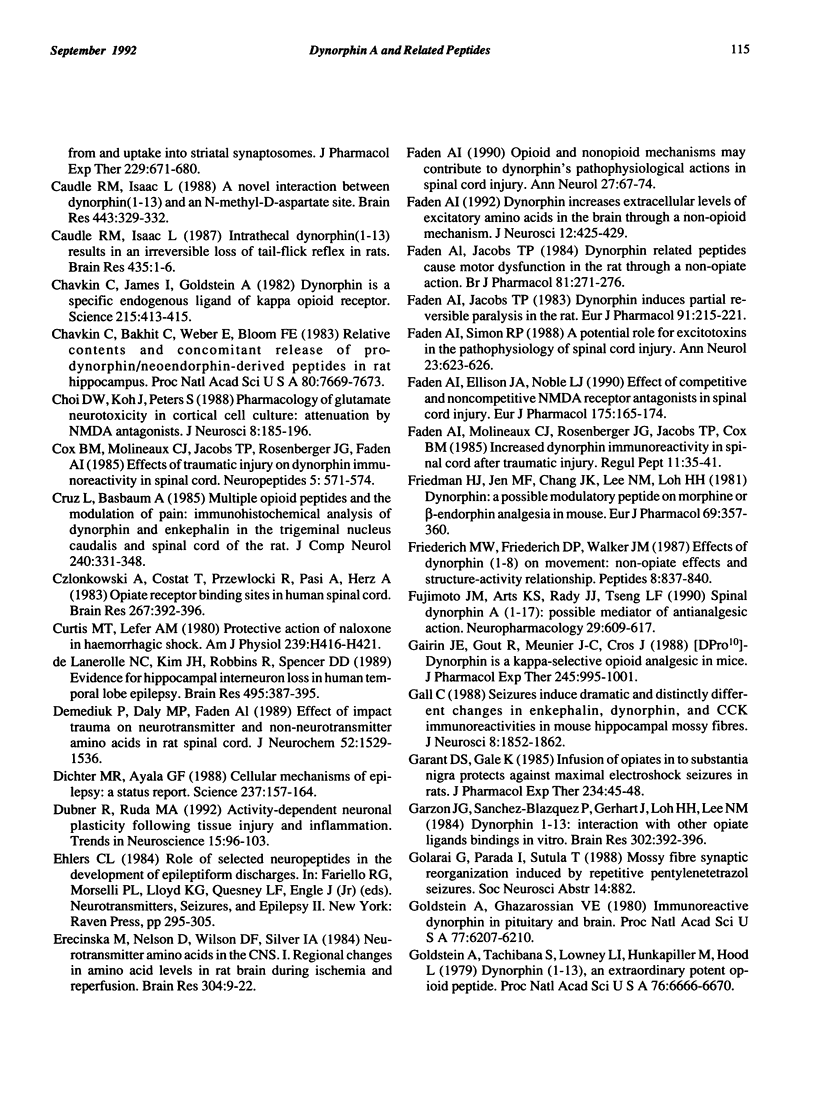

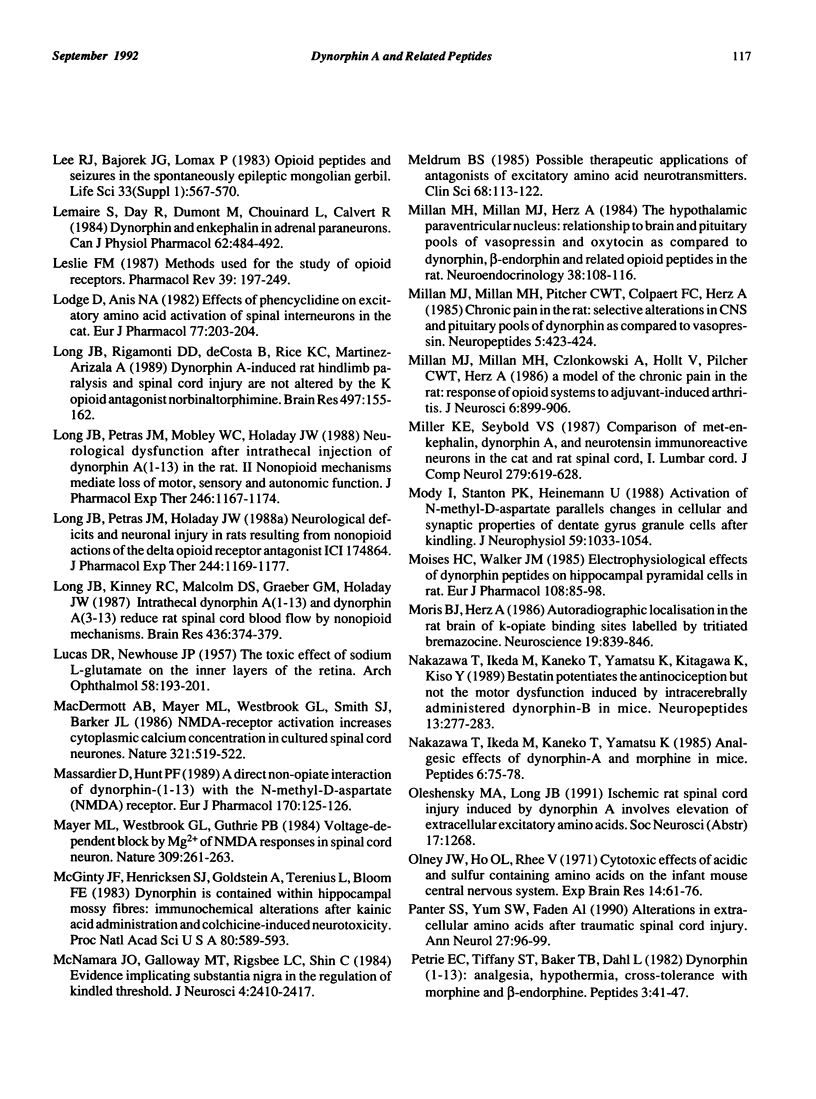
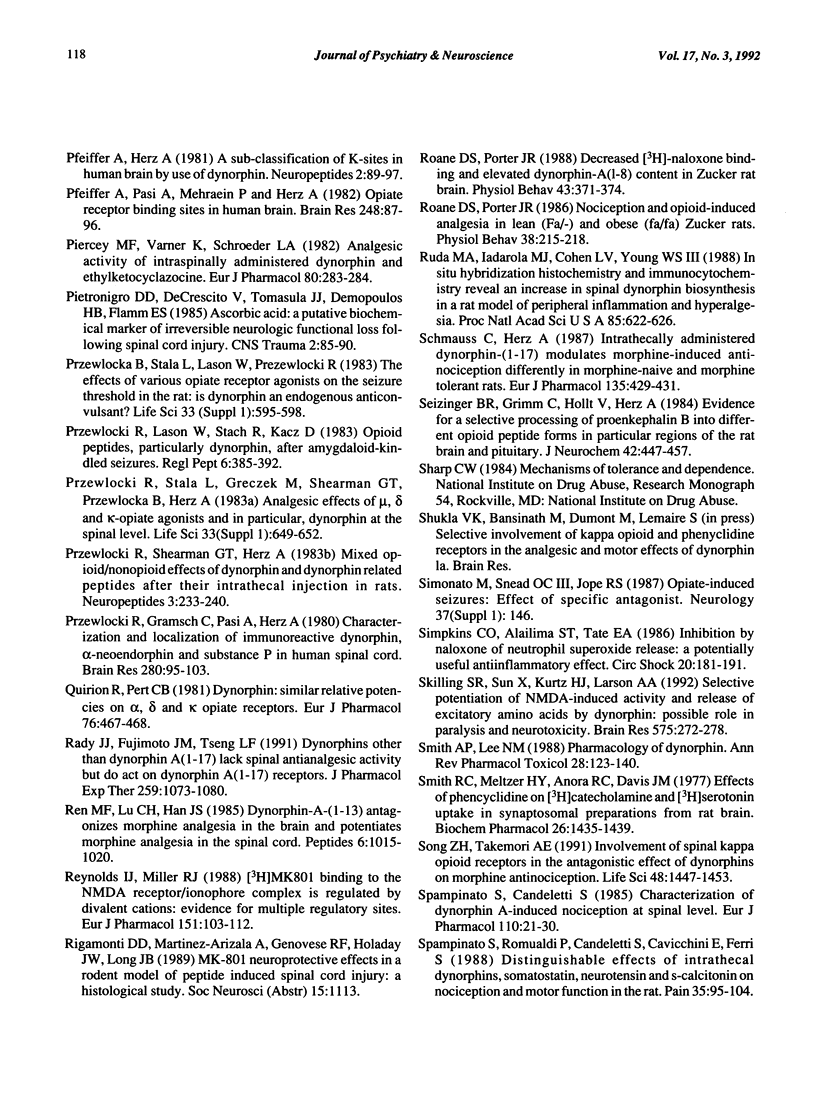

Selected References
These references are in PubMed. This may not be the complete list of references from this article.
- Bakshi R., Faden A. I. Blockade of the glycine modulatory site of NMDA receptors modifies dynorphin-induced behavioral effects. Neurosci Lett. 1990 Mar 2;110(1-2):113–117. doi: 10.1016/0304-3940(90)90797-d. [DOI] [PubMed] [Google Scholar]
- Bakshi R., Faden A. I. Competitive and non-competitive NMDA antagonists limit dynorphin A-induced rat hindlimb paralysis. Brain Res. 1990 Jan 15;507(1):1–5. doi: 10.1016/0006-8993(90)90512-a. [DOI] [PubMed] [Google Scholar]
- Bakshi R., Newman A. H., Faden A. I. Dynorphin A-(1-17) induces alterations in free fatty acids, excitatory amino acids, and motor function through an opiate-receptor-mediated mechanism. J Neurosci. 1990 Dec;10(12):3793–3800. doi: 10.1523/JNEUROSCI.10-12-03793.1990. [DOI] [PMC free article] [PubMed] [Google Scholar]
- Basbaum A. I., Fields H. L. Endogenous pain control systems: brainstem spinal pathways and endorphin circuitry. Annu Rev Neurosci. 1984;7:309–338. doi: 10.1146/annurev.ne.07.030184.001521. [DOI] [PubMed] [Google Scholar]
- Bonhaus D. W., Rigsbee L. C., McNamara J. O. Intranigral dynorphin-1-13 suppresses kindled seizures by a naloxone-insensitive mechanism. Brain Res. 1987 Mar 10;405(2):358–363. doi: 10.1016/0006-8993(87)90306-4. [DOI] [PubMed] [Google Scholar]
- Botticelli L. J., Cox B. M., Goldstein A. Immunoreactive dynorphin in mammalian spinal cord and dorsal root ganglia. Proc Natl Acad Sci U S A. 1981 Dec;78(12):7783–7786. doi: 10.1073/pnas.78.12.7783. [DOI] [PMC free article] [PubMed] [Google Scholar]
- Bowyer J. F., Spuhler K. P., Weiner N. Effects of phencyclidine, amphetamine and related compounds on dopamine release from and uptake into striatal synaptosomes. J Pharmacol Exp Ther. 1984 Jun;229(3):671–680. [PubMed] [Google Scholar]
- Caudle R. M., Isaac L. A novel interaction between dynorphin(1-13) and an N-methyl-D-aspartate site. Brain Res. 1988 Mar 8;443(1-2):329–332. doi: 10.1016/0006-8993(88)91628-9. [DOI] [PubMed] [Google Scholar]
- Caudle R. M., Isaac L. Intrathecal dynorphin(1-13) results in an irreversible loss of the tail-flick reflex in rats. Brain Res. 1987 Dec 1;435(1-2):1–6. doi: 10.1016/0006-8993(87)91579-4. [DOI] [PubMed] [Google Scholar]
- Chavkin C., Bakhit C., Weber E., Bloom F. E. Relative contents and concomitant release of prodynorphin/neoendorphin-derived peptides in rat hippocampus. Proc Natl Acad Sci U S A. 1983 Dec;80(24):7669–7673. doi: 10.1073/pnas.80.24.7669. [DOI] [PMC free article] [PubMed] [Google Scholar]
- Chavkin C., James I. F., Goldstein A. Dynorphin is a specific endogenous ligand of the kappa opioid receptor. Science. 1982 Jan 22;215(4531):413–415. doi: 10.1126/science.6120570. [DOI] [PubMed] [Google Scholar]
- Choi D. W., Koh J. Y., Peters S. Pharmacology of glutamate neurotoxicity in cortical cell culture: attenuation by NMDA antagonists. J Neurosci. 1988 Jan;8(1):185–196. doi: 10.1523/JNEUROSCI.08-01-00185.1988. [DOI] [PMC free article] [PubMed] [Google Scholar]
- Cox B. M., Molineaux C. J., Jacobs T. P., Rosenberger J. G., Faden A. I. Effects of traumatic injury on dynorphin immunoreactivity in spinal cord. Neuropeptides. 1985 Feb;5(4-6):571–574. doi: 10.1016/0143-4179(85)90082-4. [DOI] [PubMed] [Google Scholar]
- Cruz L., Basbaum A. I. Multiple opioid peptides and the modulation of pain: immunohistochemical analysis of dynorphin and enkephalin in the trigeminal nucleus caudalis and spinal cord of the cat. J Comp Neurol. 1985 Oct 22;240(4):331–348. doi: 10.1002/cne.902400402. [DOI] [PubMed] [Google Scholar]
- Curtis M. T., Lefer A. M. Protective actions of naloxone in hemorrhagic shock. Am J Physiol. 1980 Sep;239(3):H416–H421. doi: 10.1152/ajpheart.1980.239.3.H416. [DOI] [PubMed] [Google Scholar]
- Członkowski A., Costa T., Przewłocki R., Pasí A., Herz A. Opiate receptor binding sites in human spinal cord. Brain Res. 1983 May 16;267(2):392–396. doi: 10.1016/0006-8993(83)90897-1. [DOI] [PubMed] [Google Scholar]
- Demediuk P., Daly M. P., Faden A. I. Effect of impact trauma on neurotransmitter and nonneurotransmitter amino acids in rat spinal cord. J Neurochem. 1989 May;52(5):1529–1536. doi: 10.1111/j.1471-4159.1989.tb09204.x. [DOI] [PubMed] [Google Scholar]
- Dichter M. A., Ayala G. F. Cellular mechanisms of epilepsy: a status report. Science. 1987 Jul 10;237(4811):157–164. doi: 10.1126/science.3037700. [DOI] [PubMed] [Google Scholar]
- Dirksen R., Nijhuis G. M. The relevance of cholinergic transmission at the spinal level to opiate effectiveness. Eur J Pharmacol. 1983 Jul 22;91(2-3):215–221. doi: 10.1016/0014-2999(83)90467-3. [DOI] [PubMed] [Google Scholar]
- Dubner R., Ruda M. A. Activity-dependent neuronal plasticity following tissue injury and inflammation. Trends Neurosci. 1992 Mar;15(3):96–103. doi: 10.1016/0166-2236(92)90019-5. [DOI] [PubMed] [Google Scholar]
- Erecińska M., Nelson D., Wilson D. F., Silver I. A. Neurotransmitter amino acids in the CNS. I. Regional changes in amino acid levels in rat brain during ischemia and reperfusion. Brain Res. 1984 Jun 18;304(1):9–22. doi: 10.1016/0006-8993(84)90857-6. [DOI] [PubMed] [Google Scholar]
- Faden A. I. Dynorphin increases extracellular levels of excitatory amino acids in the brain through a non-opioid mechanism. J Neurosci. 1992 Feb;12(2):425–429. doi: 10.1523/JNEUROSCI.12-02-00425.1992. [DOI] [PMC free article] [PubMed] [Google Scholar]
- Faden A. I., Ellison J. A., Noble L. J. Effects of competitive and non-competitive NMDA receptor antagonists in spinal cord injury. Eur J Pharmacol. 1990 Jan 10;175(2):165–174. doi: 10.1016/0014-2999(90)90227-w. [DOI] [PubMed] [Google Scholar]
- Faden A. I., Jacobs T. P. Dynorphin-related peptides cause motor dysfunction in the rat through a non-opiate action. Br J Pharmacol. 1984 Feb;81(2):271–276. doi: 10.1111/j.1476-5381.1984.tb10074.x. [DOI] [PMC free article] [PubMed] [Google Scholar]
- Faden A. I., Molineaux C. J., Rosenberger J. G., Jacobs T. P., Cox B. M. Increased dynorphin immunoreactivity in spinal cord after traumatic injury. Regul Pept. 1985 May;11(1):35–41. doi: 10.1016/0167-0115(85)90029-1. [DOI] [PubMed] [Google Scholar]
- Faden A. I. Opioid and nonopioid mechanisms may contribute to dynorphin's pathophysiological actions in spinal cord injury. Ann Neurol. 1990 Jan;27(1):67–74. doi: 10.1002/ana.410270111. [DOI] [PubMed] [Google Scholar]
- Faden A. I., Simon R. P. A potential role for excitotoxins in the pathophysiology of spinal cord injury. Ann Neurol. 1988 Jun;23(6):623–626. doi: 10.1002/ana.410230618. [DOI] [PubMed] [Google Scholar]
- Friederich M. W., Friederich D. P., Walker J. M. Effects of dynorphin (1-8) on movement: non-opiate effects and structure-activity relationship. Peptides. 1987 Sep-Oct;8(5):837–840. doi: 10.1016/0196-9781(87)90068-4. [DOI] [PubMed] [Google Scholar]
- Friedman H. J., Jen M. F., Chang J. K., Lee N. M., Loh H. H. Dynorphin: a possible modulatory peptide on morphine or beta-endorphin analgesia in mouse. Eur J Pharmacol. 1981 Jan 29;69(3):357–360. doi: 10.1016/0014-2999(81)90483-0. [DOI] [PubMed] [Google Scholar]
- Fujimoto J. M., Arts K. S., Rady J. J., Tseng L. F. Spinal dynorphin A (1-17): possible mediator of antianalgesic action. Neuropharmacology. 1990 Jul;29(7):609–617. doi: 10.1016/0028-3908(90)90021-i. [DOI] [PubMed] [Google Scholar]
- Gairin J. E., Gout R., Meunier J. C., Cros J. [D-Pro10]-dynorphin(1-11) is a kappa-selective opioid analgesic in mice. J Pharmacol Exp Ther. 1988 Jun;245(3):995–1001. [PubMed] [Google Scholar]
- Gall C. Seizures induce dramatic and distinctly different changes in enkephalin, dynorphin, and CCK immunoreactivities in mouse hippocampal mossy fibers. J Neurosci. 1988 Jun;8(6):1852–1862. doi: 10.1523/JNEUROSCI.08-06-01852.1988. [DOI] [PMC free article] [PubMed] [Google Scholar]
- Garant D. S., Gale K. Infusion of opiates into substantia nigra protects against maximal electroshock seizures in rats. J Pharmacol Exp Ther. 1985 Jul;234(1):45–48. [PubMed] [Google Scholar]
- Garzón J., Sánchez-Blázquez P., Gerhart J., Loh H. H., Lee N. M. Dynorphin1-13: interaction with other opiate ligand bindings in vitro. Brain Res. 1984 Jun 8;302(2):392–396. doi: 10.1016/0006-8993(84)90256-7. [DOI] [PubMed] [Google Scholar]
- Goldstein A., Ghazarossian V. E. Immunoreactive dynorphin in pituitary and brain. Proc Natl Acad Sci U S A. 1980 Oct;77(10):6207–6210. doi: 10.1073/pnas.77.10.6207. [DOI] [PMC free article] [PubMed] [Google Scholar]
- Goldstein A., Tachibana S., Lowney L. I., Hunkapiller M., Hood L. Dynorphin-(1-13), an extraordinarily potent opioid peptide. Proc Natl Acad Sci U S A. 1979 Dec;76(12):6666–6670. doi: 10.1073/pnas.76.12.6666. [DOI] [PMC free article] [PubMed] [Google Scholar]
- Gramsch C., Höllt V., Pasi A., Mehraein P., Herz A. Immunoreactive dynorphin in human brain and pituitary. Brain Res. 1982 Feb 4;233(1):65–74. doi: 10.1016/0006-8993(82)90930-1. [DOI] [PubMed] [Google Scholar]
- Gruol D. L., Chavkin C., Valentino R. J., Siggins G. R. Dynorphin-A alters the excitability of pyramidal neurons of the rat hippocampus in vitro. Life Sci. 1983;33 (Suppl 1):533–536. doi: 10.1016/0024-3205(83)90558-1. [DOI] [PubMed] [Google Scholar]
- Han J. S., Xie C. W. Dynorphin: potent analgesic effect in spinal cord of the rat. Sci Sin B. 1984 Feb;27(2):169–177. [PubMed] [Google Scholar]
- Hayes A. G., Skingle M., Tyers M. B. Antinociceptive profile of dynorphin in the rat. Life Sci. 1983;33 (Suppl 1):657–660. doi: 10.1016/0024-3205(83)90588-x. [DOI] [PubMed] [Google Scholar]
- Henriksen S. J., Chouvet G., Bloom F. E. In vivo cellular responses to electrophoretically applied dynorphin in the rat hippocampus. Life Sci. 1982 Oct 18;31(16-17):1785–1788. doi: 10.1016/0024-3205(82)90210-7. [DOI] [PubMed] [Google Scholar]
- Herman B. H., Goldstein A. Antinociception and paralysis induced by intrathecal dynorphin A. J Pharmacol Exp Ther. 1985 Jan;232(1):27–32. [PubMed] [Google Scholar]
- Herman B. H., Leslie F., Goldstein A. Behavioral effects and in vivo degradation of intraventricularly administered dynorphin-(1-13) and D-Ala2-dynorphin-(1-11) in rats. Life Sci. 1980 Sep 8;27(10):883–892. doi: 10.1016/0024-3205(80)90084-3. [DOI] [PubMed] [Google Scholar]
- Herrera-Marschitz M., Hökfelt T., Ungerstedt U., Terenius L., Goldstein M. Effect of intranigral injections of dynorphin, dynorphin fragments and alpha-neoendorphin on rotational behaviour in the rat. Eur J Pharmacol. 1984 Jul 13;102(2):213–227. doi: 10.1016/0014-2999(84)90253-x. [DOI] [PubMed] [Google Scholar]
- Hoffman D. W., Zamir N. Localization and quantitation of dynorphin B in the rat hippocampus. Brain Res. 1984 Dec 24;324(2):354–357. doi: 10.1016/0006-8993(84)90048-9. [DOI] [PubMed] [Google Scholar]
- Houser C. R., Miyashiro J. E., Swartz B. E., Walsh G. O., Rich J. R., Delgado-Escueta A. V. Altered patterns of dynorphin immunoreactivity suggest mossy fiber reorganization in human hippocampal epilepsy. J Neurosci. 1990 Jan;10(1):267–282. doi: 10.1523/JNEUROSCI.10-01-00267.1990. [DOI] [PMC free article] [PubMed] [Google Scholar]
- Höllt V., Haarmann I., Millan M. J., Herz A. Prodynorphin gene expression is enhanced in the spinal cord of chronic arthritic rats. Neurosci Lett. 1987 Jan 2;73(1):90–94. doi: 10.1016/0304-3940(87)90037-1. [DOI] [PubMed] [Google Scholar]
- Iadarola M. J., Shin C., McNamara J. O., Yang H. Y. Changes in dynorphin, enkephalin and cholecystokinin content of hippocampus and substantia nigra after amygdala kindling. Brain Res. 1986 Feb 12;365(1):185–191. doi: 10.1016/0006-8993(86)90738-9. [DOI] [PubMed] [Google Scholar]
- Isaac L., Van Zandt O'Malley T., Ristic H., Stewart P. MK-801 blocks dynorphin A (1-13)-induced loss of the tail-flick reflex in the rat. Brain Res. 1990 Oct 29;531(1-2):83–87. doi: 10.1016/0006-8993(90)90760-9. [DOI] [PubMed] [Google Scholar]
- Iwama T., Ishihara K., Satoh M., Takagi H. Different effects of dynorphin A on in vitro guinea pig hippocampal CA3 pyramidal cells with various degrees of paired-pulse facilitation. Neurosci Lett. 1986 Jan 16;63(2):190–194. doi: 10.1016/0304-3940(86)90060-1. [DOI] [PubMed] [Google Scholar]
- James I. F., Goldstein A. Site-directed alkylation of multiple opioid receptors. I. Binding selectivity. Mol Pharmacol. 1984 May;25(3):337–342. [PubMed] [Google Scholar]
- Jhamandas K., Sutak M., Lemaire S. Comparative spinal analgesic action of dynorphin1-8, dynorphin1-13, and a kappa-receptor agonist U50,488. Can J Physiol Pharmacol. 1986 Mar;64(3):263–268. doi: 10.1139/y86-042. [DOI] [PubMed] [Google Scholar]
- Johnson J. W., Ascher P. Glycine potentiates the NMDA response in cultured mouse brain neurons. Nature. 1987 Feb 5;325(6104):529–531. doi: 10.1038/325529a0. [DOI] [PubMed] [Google Scholar]
- Johnson K. M., Snell L. D. Effects of phencyclidine (PCP)-like drugs on turning behavior, 3H-dopamine uptake, and 3H-PCP binding. Pharmacol Biochem Behav. 1985 May;22(5):731–735. doi: 10.1016/0091-3057(85)90521-0. [DOI] [PubMed] [Google Scholar]
- Kanamatsu T., McGinty J. F., Mitchell C. L., Hong J. S. Dynorphin- and enkephalin-like immunoreactivity is altered in limbic-basal ganglia regions of rat brain after repeated electroconvulsive shock. J Neurosci. 1986 Mar;6(3):644–649. doi: 10.1523/JNEUROSCI.06-03-00644.1986. [DOI] [PMC free article] [PubMed] [Google Scholar]
- Kanamatsu T., Obie J., Grimes L., McGinty J. F., Yoshikawa K., Sabol S., Hong J. S. Kainic acid alters the metabolism of Met5-enkephalin and the level of dynorphin A in the rat hippocampus. J Neurosci. 1986 Oct;6(10):3094–3102. doi: 10.1523/JNEUROSCI.06-10-03094.1986. [DOI] [PMC free article] [PubMed] [Google Scholar]
- Kaneko T., Nakazawa T., Ikeda M., Yamatsu K., Iwama T., Wada T., Satoh M., Takagi H. Sites of analgesic action of dynorphin. Life Sci. 1983;33 (Suppl 1):661–664. doi: 10.1016/0024-3205(83)90589-1. [DOI] [PubMed] [Google Scholar]
- Kangawa K., Matsuo H. alpha-Neo-endorphin : a "big" Leu-enkephalin with potent opiate activity from porcine hypothalami. Biochem Biophys Res Commun. 1979 Jan 15;86(1):153–160. doi: 10.1016/0006-291x(79)90394-2. [DOI] [PubMed] [Google Scholar]
- Khachaturian H., Watson S. J., Lewis M. E., Coy D., Goldstein A., Akil H. Dynorphin immunocytochemistry in the rat central nervous system. Peptides. 1982 Nov-Dec;3(6):941–954. doi: 10.1016/0196-9781(82)90063-8. [DOI] [PubMed] [Google Scholar]
- Kilpatrick D. L., Wahlstrom A., Lahm H. W., Blacher R., Udenfriend S. Rimorphin, a unique, naturally occurring [Leu]enkephalin-containing peptide found in association with dynorphin and alpha-neo-endorphin. Proc Natl Acad Sci U S A. 1982 Nov;79(21):6480–6483. doi: 10.1073/pnas.79.21.6480. [DOI] [PMC free article] [PubMed] [Google Scholar]
- Koek W., Colpaert F. C. Selective blockade of N-methyl-D-aspartate (NMDA)-induced convulsions by NMDA antagonists and putative glycine antagonists: relationship with phencyclidine-like behavioral effects. J Pharmacol Exp Ther. 1990 Jan;252(1):349–357. [PubMed] [Google Scholar]
- Koŕeh K., Seligman M. L., Flamm E. S., Demopoulos H. B. Lipid antioxidant properties of naloxone in vitro. Biochem Biophys Res Commun. 1981 Oct 30;102(4):1317–1322. doi: 10.1016/s0006-291x(81)80155-6. [DOI] [PubMed] [Google Scholar]
- LUCAS D. R., NEWHOUSE J. P. The toxic effect of sodium L-glutamate on the inner layers of the retina. AMA Arch Ophthalmol. 1957 Aug;58(2):193–201. doi: 10.1001/archopht.1957.00940010205006. [DOI] [PubMed] [Google Scholar]
- Landahl H. D., Garzón J., Lee N. M. Mathematical modeling of opiate binding to mouse brain membrane. Bull Math Biol. 1985;47(4):503–512. doi: 10.1007/BF02460010. [DOI] [PubMed] [Google Scholar]
- Lee R. J., Bajorek J. G., Lomax P. Opioid peptides and seizures in the spontaneously epileptic Mongolian gerbil. Life Sci. 1983;33 (Suppl 1):567–570. doi: 10.1016/0024-3205(83)90566-0. [DOI] [PubMed] [Google Scholar]
- Lemaire S., Day R., Dumont M., Chouinard L., Calvert R. Dynorphin and enkephalins in adrenal paraneurones. Opiates in the adrenal medulla. Can J Physiol Pharmacol. 1984 Apr;62(4):484–492. doi: 10.1139/y84-078. [DOI] [PubMed] [Google Scholar]
- Leslie F. M. Methods used for the study of opioid receptors. Pharmacol Rev. 1987 Sep;39(3):197–249. [PubMed] [Google Scholar]
- Lodge D., Anis N. A. Effects of phencyclidine on excitatory amino acid activation of spinal interneurones in the cat. Eur J Pharmacol. 1982 Jan 22;77(2-3):203–204. doi: 10.1016/0014-2999(82)90022-x. [DOI] [PubMed] [Google Scholar]
- Long J. B., Kinney R. C., Malcolm D. S., Graeber G. M., Holaday J. W. Intrathecal dynorphin A1-13 and dynorphin A3-13 reduce rat spinal cord blood flow by non-opioid mechanisms. Brain Res. 1987 Dec 15;436(2):374–379. doi: 10.1016/0006-8993(87)91683-0. [DOI] [PubMed] [Google Scholar]
- Long J. B., Petras J. M., Holaday J. W. Neurologic deficits and neuronal injury in rats resulting from nonopioid actions of the delta opioid receptor antagonist ICI 174864. J Pharmacol Exp Ther. 1988 Mar;244(3):1169–1177. [PubMed] [Google Scholar]
- Long J. B., Petras J. M., Mobley W. C., Holaday J. W. Neurological dysfunction after intrathecal injection of dynorphin A (1-13) in the rat. II. Nonopioid mechanisms mediate loss of motor, sensory and autonomic function. J Pharmacol Exp Ther. 1988 Sep;246(3):1167–1174. [PubMed] [Google Scholar]
- Long J. B., Rigamonti D. D., de Costa B., Rice K. C., Martinez-Arizala A. Dynorphin A-induced rat hindlimb paralysis and spinal cord injury are not altered by the kappa opioid antagonist nor-binaltorphimine. Brain Res. 1989 Sep 11;497(1):155–162. doi: 10.1016/0006-8993(89)90982-7. [DOI] [PubMed] [Google Scholar]
- MacDermott A. B., Mayer M. L., Westbrook G. L., Smith S. J., Barker J. L. NMDA-receptor activation increases cytoplasmic calcium concentration in cultured spinal cord neurones. 1986 May 29-Jun 4Nature. 321(6069):519–522. doi: 10.1038/321519a0. [DOI] [PubMed] [Google Scholar]
- Massardier D., Hunt P. F. A direct non-opiate interaction of dynorphin-(1-13) with the N-methyl-D-aspartate (NMDA) receptor. Eur J Pharmacol. 1989 Oct 24;170(1-2):125–126. doi: 10.1016/0014-2999(89)90149-0. [DOI] [PubMed] [Google Scholar]
- Mayer M. L., Westbrook G. L., Guthrie P. B. Voltage-dependent block by Mg2+ of NMDA responses in spinal cord neurones. Nature. 1984 May 17;309(5965):261–263. doi: 10.1038/309261a0. [DOI] [PubMed] [Google Scholar]
- McGinty J. F., Henriksen S. J., Goldstein A., Terenius L., Bloom F. E. Dynorphin is contained within hippocampal mossy fibers: immunochemical alterations after kainic acid administration and colchicine-induced neurotoxicity. Proc Natl Acad Sci U S A. 1983 Jan;80(2):589–593. doi: 10.1073/pnas.80.2.589. [DOI] [PMC free article] [PubMed] [Google Scholar]
- McNamara J. O., Galloway M. T., Rigsbee L. C., Shin C. Evidence implicating substantia nigra in regulation of kindled seizure threshold. J Neurosci. 1984 Sep;4(9):2410–2417. doi: 10.1523/JNEUROSCI.04-09-02410.1984. [DOI] [PMC free article] [PubMed] [Google Scholar]
- Meldrum B. Possible therapeutic applications of antagonists of excitatory amino acid neurotransmitters. Clin Sci (Lond) 1985 Feb;68(2):113–122. doi: 10.1042/cs0680113. [DOI] [PubMed] [Google Scholar]
- Millan M. H., Millan M. J., Herz A. The hypothalamic paraventricular nucleus: relationship to brain and pituitary pools of vasopressin and oxytocin as compared to dynorphin, beta-endorphin and related opioid peptides in the rat. Neuroendocrinology. 1984 Feb;38(2):108–116. doi: 10.1159/000123877. [DOI] [PubMed] [Google Scholar]
- Millan M. J., Millan M. H., Członkowski A., Höllt V., Pilcher C. W., Herz A., Colpaert F. C. A model of chronic pain in the rat: response of multiple opioid systems to adjuvant-induced arthritis. J Neurosci. 1986 Apr;6(4):899–906. doi: 10.1523/JNEUROSCI.06-04-00899.1986. [DOI] [PMC free article] [PubMed] [Google Scholar]
- Millan M. J., Millan M. H., Pilcher C. W., Colpaert F. C., Herz A. Chronic pain in the rat: selective alterations in CNS and pituitary pools of dynorphin as compared to vasopressin. Neuropeptides. 1985 Feb;5(4-6):423–424. doi: 10.1016/0143-4179(85)90044-7. [DOI] [PubMed] [Google Scholar]
- Miller K. E., Seybold V. S. Comparison of met-enkephalin, dynorphin A, and neurotensin immunoreactive neurons in the cat and rat spinal cords: II. Segmental differences in the marginal zone. J Comp Neurol. 1989 Jan 22;279(4):619–628. doi: 10.1002/cne.902790409. [DOI] [PubMed] [Google Scholar]
- Mody I., Stanton P. K., Heinemann U. Activation of N-methyl-D-aspartate receptors parallels changes in cellular and synaptic properties of dentate gyrus granule cells after kindling. J Neurophysiol. 1988 Mar;59(3):1033–1054. doi: 10.1152/jn.1988.59.3.1033. [DOI] [PubMed] [Google Scholar]
- Moises H. C., Walker J. M. Electrophysiological effects of dynorphin peptides on hippocampal pyramidal cells in rat. Eur J Pharmacol. 1985 Jan 15;108(1):85–98. doi: 10.1016/0014-2999(85)90286-9. [DOI] [PubMed] [Google Scholar]
- Morris B. J., Herz A. Autoradiographic localization in rat brain of kappa opiate binding sites labelled by [3H]bremazocine. Neuroscience. 1986 Nov;19(3):839–846. doi: 10.1016/0306-4522(86)90302-7. [DOI] [PubMed] [Google Scholar]
- Nakazawa T., Ikeda M., Kaneko T., Yamatsu K. Analgesic effects of dynorphin-A and morphine in mice. Peptides. 1985 Jan-Feb;6(1):75–78. doi: 10.1016/0196-9781(85)90079-8. [DOI] [PubMed] [Google Scholar]
- Nakazawa T., Ikeda M., Kaneko T., Yamatsu K., Kitagawa K., Kiso Y. Bestatin potentiates the antinociception but not the motor dysfunction induced by intracerebrally administered dynorphin-B in mice. Neuropeptides. 1989 May-Jun;13(4):277–283. doi: 10.1016/0143-4179(89)90082-6. [DOI] [PubMed] [Google Scholar]
- Olney J. W., Ho O. L., Rhee V. Cytotoxic effects of acidic and sulphur containing amino acids on the infant mouse central nervous system. Exp Brain Res. 1971;14(1):61–76. doi: 10.1007/BF00234911. [DOI] [PubMed] [Google Scholar]
- Panter S. S., Yum S. W., Faden A. I. Alteration in extracellular amino acids after traumatic spinal cord injury. Ann Neurol. 1990 Jan;27(1):96–99. doi: 10.1002/ana.410270115. [DOI] [PubMed] [Google Scholar]
- Petrie E. C., Tiffany S. T., Baker T. B., Dahl J. L. Dynorphin (1-13): analgesia, hypothermia, cross-tolerance with morphine and beta-endorphin. Peptides. 1982 Jan-Feb;3(1):41–47. doi: 10.1016/0196-9781(82)90140-1. [DOI] [PubMed] [Google Scholar]
- Pfeiffer A., Pasi A., Mehraein P., Herz A. Opiate receptor binding sites in human brain. Brain Res. 1982 Sep 23;248(1):87–96. doi: 10.1016/0006-8993(82)91150-7. [DOI] [PubMed] [Google Scholar]
- Piercey M. F., Varner K., Schroeder L. A. Analgesic activity of intraspinally administered dynorphin and ethylketocyclazocine. Eur J Pharmacol. 1982 May 21;80(2-3):283–284. doi: 10.1016/0014-2999(82)90072-3. [DOI] [PubMed] [Google Scholar]
- Pietronigro D. D., DeCrescito V., Tomasula J. J., Demopoulos H. B., Flamm E. S. Ascorbic acid: a putative biochemical marker of irreversible neurologic functional loss following spinal cord injury. Cent Nerv Syst Trauma. 1985 Summer;2(2):85–92. doi: 10.1089/cns.1985.2.85. [DOI] [PubMed] [Google Scholar]
- Przewłocka B., Stala L., Lasoń W., Przewłocki R. The effect of various opiate receptor agonists on the seizure threshold in the rat. Is dynorphin an endogenous anticonvulsant? Life Sci. 1983;33 (Suppl 1):595–598. doi: 10.1016/0024-3205(83)90573-8. [DOI] [PubMed] [Google Scholar]
- Przewłocki R., Gramsch C., Pasi A., Herz A. Characterization and localization of immunoreactive dynorphin, alpha-neo-endorphin, Met-enkephalin and substance P in human spinal cord. Brain Res. 1983 Nov 28;280(1):95–103. doi: 10.1016/0006-8993(83)91177-0. [DOI] [PubMed] [Google Scholar]
- Przewłocki R., Lasoń W., Stach R., Kacz D. Opioid peptides, particularly dynorphin, after amygdaloid-kindled seizures. Regul Pept. 1983 Aug;6(4):385–392. doi: 10.1016/0167-0115(83)90268-9. [DOI] [PubMed] [Google Scholar]
- Przewłocki R., Shearman G. T., Herz A. Mixed opioid/nonopioid effects of dynorphin and dynorphin related peptides after their intrathecal injection in rats. Neuropeptides. 1983 Jan;3(3):233–240. doi: 10.1016/0143-4179(83)90019-7. [DOI] [PubMed] [Google Scholar]
- Przewłocki R., Stala L., Greczek M., Shearman G. T., Przewłocka B., Herz A. Analgesic effects of mu-, delta- and kappa-opiate agonists and, in particular, dynorphin at the spinal level. Life Sci. 1983;33 (Suppl 1):649–652. doi: 10.1016/0024-3205(83)90586-6. [DOI] [PubMed] [Google Scholar]
- Quirion R., Pert C. B. Dynorphins: similar relative potencies on mu, delta- and kappa-opiate receptors. Eur J Pharmacol. 1981 Dec 17;76(4):467–468. doi: 10.1016/0014-2999(81)90125-4. [DOI] [PubMed] [Google Scholar]
- Rady J. J., Fujimoto J. M., Tseng L. F. Dynorphins other than dynorphin A(1-17) lack spinal antianalgesic activity but do act on dynorphin A(1-17) receptors. J Pharmacol Exp Ther. 1991 Dec;259(3):1073–1080. [PubMed] [Google Scholar]
- Ren M. F., Lu C. H., Han J. S. Dynorphin-A-(1-13) antagonizes morphine analgesia in the brain and potentiates morphine analgesia in the spinal cord. Peptides. 1985 Nov-Dec;6(6):1015–1020. doi: 10.1016/0196-9781(85)90423-1. [DOI] [PubMed] [Google Scholar]
- Reynolds I. J., Miller R. J. [3H]MK801 binding to the NMDA receptor/ionophore complex is regulated by divalent cations: evidence for multiple regulatory sites. Eur J Pharmacol. 1988 Jun 22;151(1):103–112. doi: 10.1016/0014-2999(88)90697-8. [DOI] [PubMed] [Google Scholar]
- Roane D. S., Iadarola M. J., Porter J. R. Decreased [3H]-naloxone binding and elevated dynorphin-A(1-8) content in Zucker rat brain. Physiol Behav. 1988;43(3):371–374. doi: 10.1016/0031-9384(88)90201-6. [DOI] [PubMed] [Google Scholar]
- Roane D. S., Porter J. R. Nociception and opioid-induced analgesia in lean (Fa/-) and obese (fa/fa) Zucker rats. Physiol Behav. 1986;38(2):215–218. doi: 10.1016/0031-9384(86)90156-3. [DOI] [PubMed] [Google Scholar]
- Ruda M. A., Iadarola M. J., Cohen L. V., Young W. S., 3rd In situ hybridization histochemistry and immunocytochemistry reveal an increase in spinal dynorphin biosynthesis in a rat model of peripheral inflammation and hyperalgesia. Proc Natl Acad Sci U S A. 1988 Jan;85(2):622–626. doi: 10.1073/pnas.85.2.622. [DOI] [PMC free article] [PubMed] [Google Scholar]
- Schmauss C., Herz A. Intrathecally administered dynorphin-(1-17) modulates morphine-induced antinociception differently in morphine-naive and morphine-tolerant rats. Eur J Pharmacol. 1987 Mar 31;135(3):429–431. doi: 10.1016/0014-2999(87)90695-9. [DOI] [PubMed] [Google Scholar]
- Seizinger B. R., Grimm C., Höllt V., Herz A. Evidence for a selective processing of proenkephalin B into different opioid peptide forms in particular regions of rat brain and pituitary. J Neurochem. 1984 Feb;42(2):447–457. doi: 10.1111/j.1471-4159.1984.tb02698.x. [DOI] [PubMed] [Google Scholar]
- Simpkins C. O., Alailima S. T., Tate E. A. Inhibition by naloxone of neutrophil superoxide release: a potentially useful antiinflammatory effect. Circ Shock. 1986;20(3):181–191. [PubMed] [Google Scholar]
- Skilling S. R., Sun X., Kurtz H. J., Larson A. A. Selective potentiation of NMDA-induced activity and release of excitatory amino acids by dynorphin: possible roles in paralysis and neurotoxicity. Brain Res. 1992 Mar 20;575(2):272–278. doi: 10.1016/0006-8993(92)90090-v. [DOI] [PubMed] [Google Scholar]
- Smith A. P., Lee N. M. Pharmacology of dynorphin. Annu Rev Pharmacol Toxicol. 1988;28:123–140. doi: 10.1146/annurev.pa.28.040188.001011. [DOI] [PubMed] [Google Scholar]
- Smith R. C., Meltzer H. Y., Arora R. C., Davis J. M. Effects of phencyclidine on [3H]catecholamine and [3H]serotonin uptake in synaptosomal preparations from rat brain. Biochem Pharmacol. 1977 Aug 1;26(15):1435–1439. doi: 10.1016/0006-2952(77)90370-7. [DOI] [PubMed] [Google Scholar]
- Song Z. H., Takemori A. E. Involvement of spinal kappa opioid receptors in the antagonistic effect of dynorphins on morphine antinociception. Life Sci. 1991;48(15):1447–1453. doi: 10.1016/0024-3205(91)90181-a. [DOI] [PubMed] [Google Scholar]
- Spampinato S., Candeletti S. Characterization of dynorphin A-induced antinociception at spinal level. Eur J Pharmacol. 1985 Mar 26;110(1):21–30. doi: 10.1016/0014-2999(85)90024-x. [DOI] [PubMed] [Google Scholar]
- Spampinato S., Romualdi P., Candeletti S., Cavicchini E., Ferri S. Distinguishable effects of intrathecal dynorphins, somatostatin, neurotensin and s-calcitonin on nociception and motor function in the rat. Pain. 1988 Oct;35(1):95–104. doi: 10.1016/0304-3959(88)90281-3. [DOI] [PubMed] [Google Scholar]
- Stevens C. W., Yaksh T. L. Dynorphin A and related peptides administered intrathecally in the rat: a search for putative kappa opiate receptor activity. J Pharmacol Exp Ther. 1986 Sep;238(3):833–838. [PubMed] [Google Scholar]
- Stewart P., Isaac L. Localization of dynorphin-induced neurotoxicity in rat spinal cord. Life Sci. 1989;44(20):1505–1514. doi: 10.1016/0024-3205(89)90330-5. [DOI] [PubMed] [Google Scholar]
- Sutula T., He X. X., Cavazos J., Scott G. Synaptic reorganization in the hippocampus induced by abnormal functional activity. Science. 1988 Mar 4;239(4844):1147–1150. doi: 10.1126/science.2449733. [DOI] [PubMed] [Google Scholar]
- Terrian D. M., Hernandez P. G., Rea M. A., Peters R. I. ATP release, adenosine formation, and modulation of dynorphin and glutamic acid release by adenosine analogues in rat hippocampal mossy fiber synaptosomes. J Neurochem. 1989 Nov;53(5):1390–1399. doi: 10.1111/j.1471-4159.1989.tb08529.x. [DOI] [PubMed] [Google Scholar]
- Terrian D. M., Johnston D., Claiborne B. J., Ansah-Yiadom R., Strittmatter W. J., Rea M. A. Glutamate and dynorphin release from a subcellular fraction enriched in hippocampal mossy fiber synaptosomes. Brain Res Bull. 1988 Sep;21(3):343–351. doi: 10.1016/0361-9230(88)90146-3. [DOI] [PubMed] [Google Scholar]
- Thornhill J. A., Gregor L., Mathison R., Pittman Q. Intrathecal dynorphin A administration causes pressor responses in rats associated with an increased resistance to spinal cord blood flow. Brain Res. 1989 Jun 19;490(1):174–177. doi: 10.1016/0006-8993(89)90447-2. [DOI] [PubMed] [Google Scholar]
- Tortella F. C. Endogenous opioid peptides and epilepsy: quieting the seizing brain? Trends Pharmacol Sci. 1988 Oct;9(10):366–372. doi: 10.1016/0165-6147(88)90256-8. [DOI] [PubMed] [Google Scholar]
- Tortella F. C., Holaday J. W. Dynorphin A (1-13): in vivo opioid antagonist actions and non-opioid anticonvulsant effects in the rat flurothyl test. NIDA Res Monogr. 1986;75:539–542. [PubMed] [Google Scholar]
- Tulunay F. C., Jen M. F., Chang J. K., Loh H. H., Lee N. M. Possible regulatory role of dynorphin on morphine- and beta-endorphin-induced analgesia. J Pharmacol Exp Ther. 1981 Nov;219(2):296–298. [PubMed] [Google Scholar]
- Vignon J., Lazdunski M. Structure-function relationships in the inhibition of synaptosomal dopamine uptake by phencyclidine and analogues: potential correlation with binding site identified with [3H]phencyclidine. Biochem Pharmacol. 1984 Feb 15;33(4):700–702. doi: 10.1016/0006-2952(84)90333-2. [DOI] [PubMed] [Google Scholar]
- Vincent S. R., Hökfelt T., Christensson I., Terenius L. Dynorphin-immunoreactive neurons in the central nervous system of the rat. Neurosci Lett. 1982 Nov 30;33(2):185–190. doi: 10.1016/0304-3940(82)90249-x. [DOI] [PubMed] [Google Scholar]
- Walker J. M., Moises H. C., Coy D. H., Baldrighi G., Akil H. Nonopiate effects of dynorphin and des-Tyr-dynorphin. Science. 1982 Dec 10;218(4577):1136–1138. doi: 10.1126/science.6128791. [DOI] [PubMed] [Google Scholar]
- Walker J. M., Moises H. C., Coy D. H., Young E. A., Watson S. J., Akil H. Dynorphin (1-17): lack of analgesia but evidence for non-opiate electrophysiological and motor effects. Life Sci. 1982 Oct 18;31(16-17):1821–1824. doi: 10.1016/0024-3205(82)90219-3. [DOI] [PubMed] [Google Scholar]
- Walker J. M., Tucker D. E., Coy D. H., Walker B. B., Akil H. Des-tyrosine-dynorphin antagonizes morphine analgesia. Eur J Pharmacol. 1982 Nov 5;85(1):121–122. doi: 10.1016/0014-2999(82)90433-2. [DOI] [PubMed] [Google Scholar]
- Weber E., Evans C. J., Barchas J. D. Predominance of the amino-terminal octapeptide fragment of dynorphin in rat brain regions. Nature. 1982 Sep 2;299(5878):77–79. doi: 10.1038/299077a0. [DOI] [PubMed] [Google Scholar]
- Weihe E., Hartschuh W., Weber E. Prodynorphin opioid peptides in small somatosensory primary afferents of guinea pig. Neurosci Lett. 1985 Aug 5;58(3):347–352. doi: 10.1016/0304-3940(85)90079-5. [DOI] [PubMed] [Google Scholar]
- Westbrook G. L., Mayer M. L. Micromolar concentrations of Zn2+ antagonize NMDA and GABA responses of hippocampal neurons. Nature. 1987 Aug 13;328(6131):640–643. doi: 10.1038/328640a0. [DOI] [PubMed] [Google Scholar]
- de Lanerolle N. C., Kim J. H., Robbins R. J., Spencer D. D. Hippocampal interneuron loss and plasticity in human temporal lobe epilepsy. Brain Res. 1989 Aug 28;495(2):387–395. doi: 10.1016/0006-8993(89)90234-5. [DOI] [PubMed] [Google Scholar]


